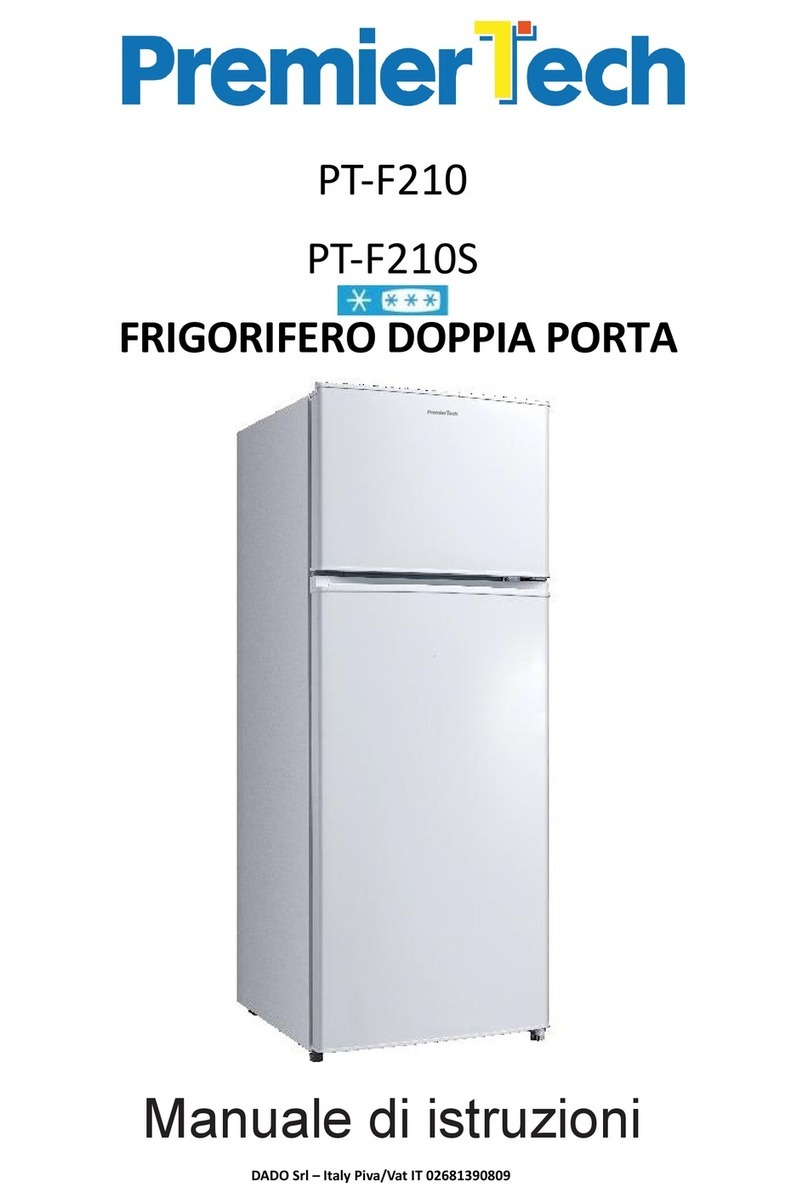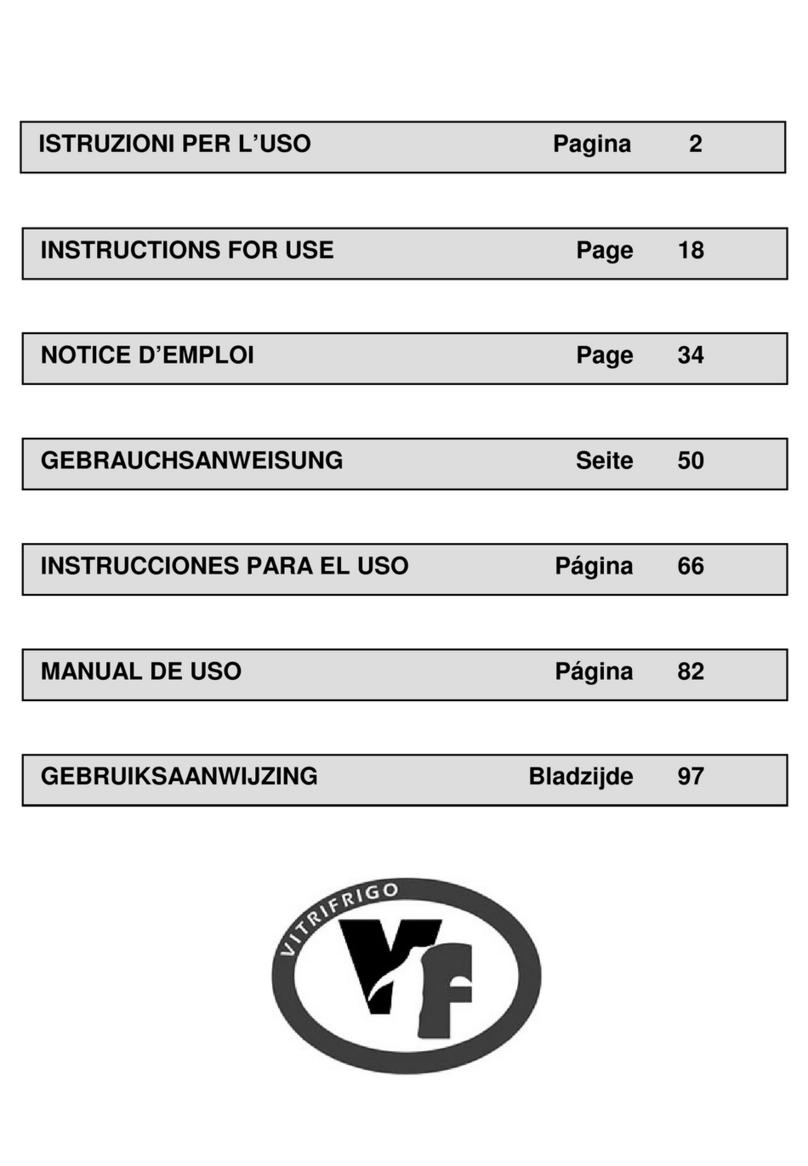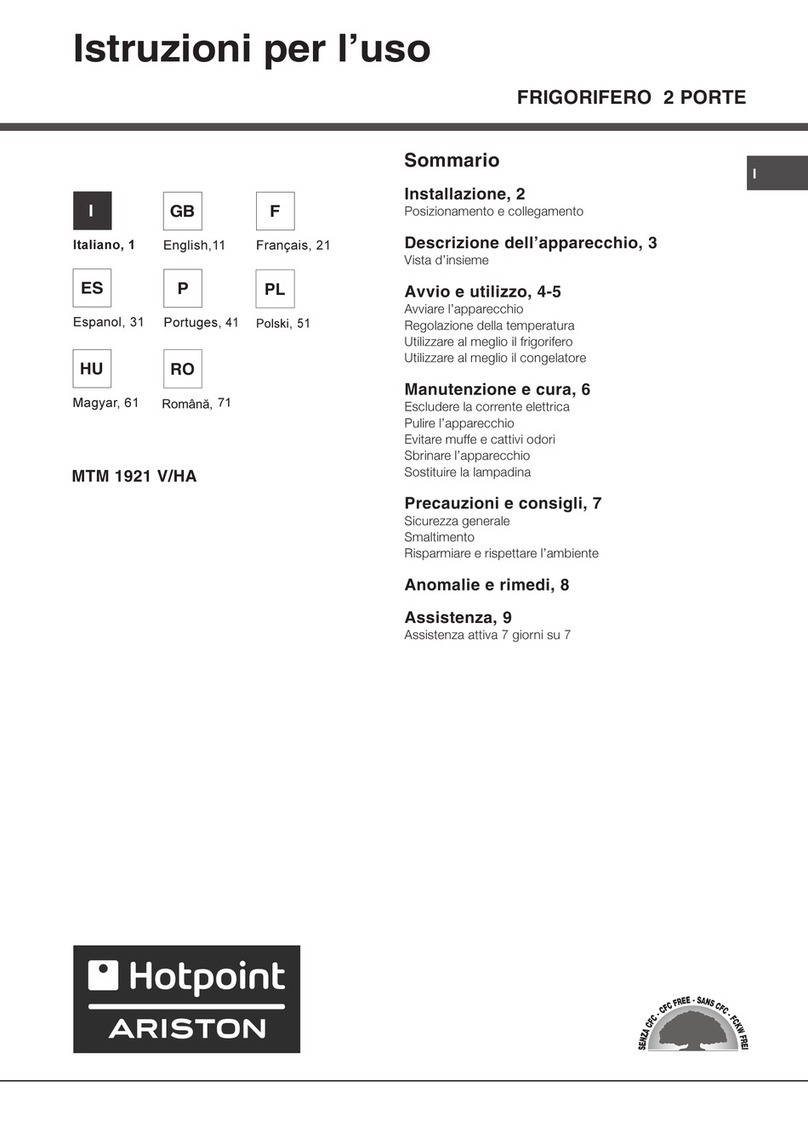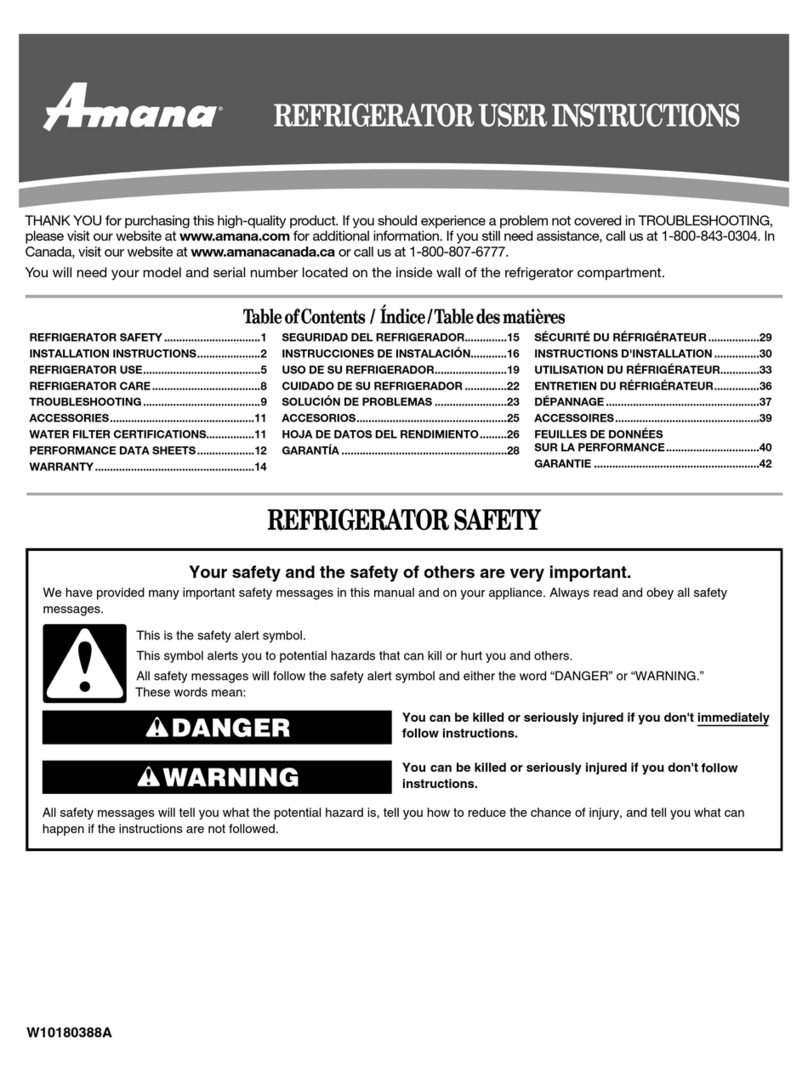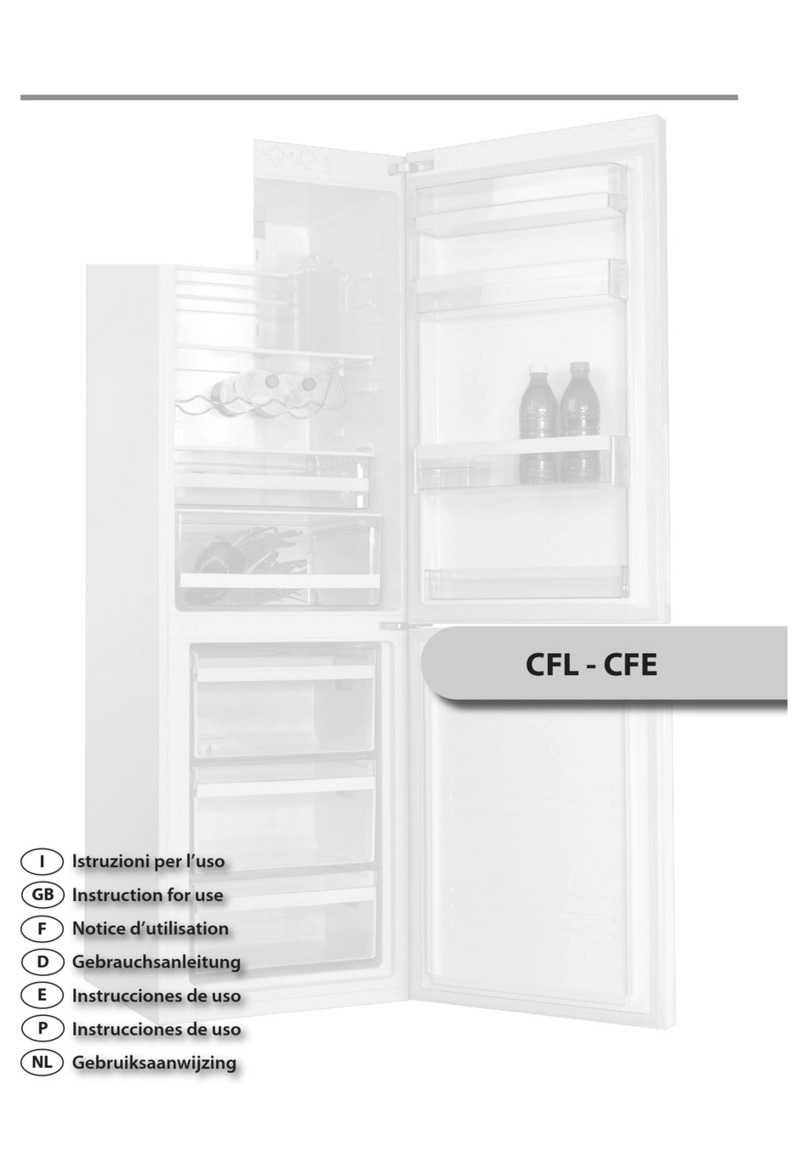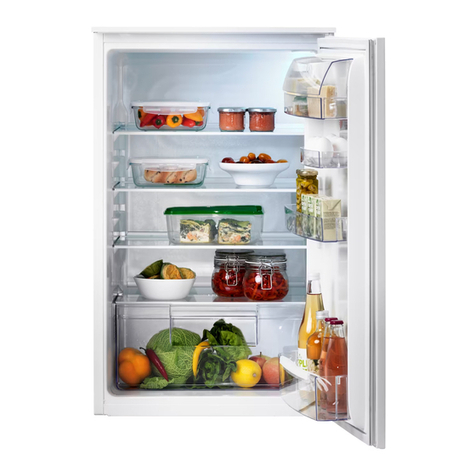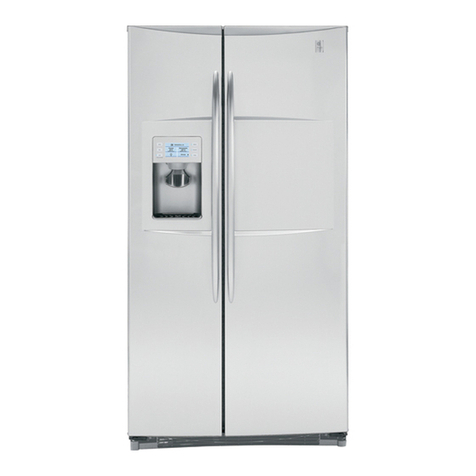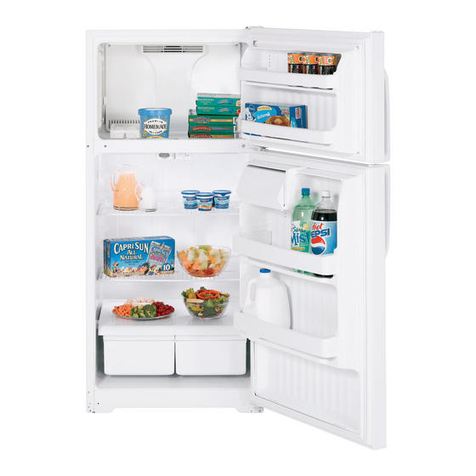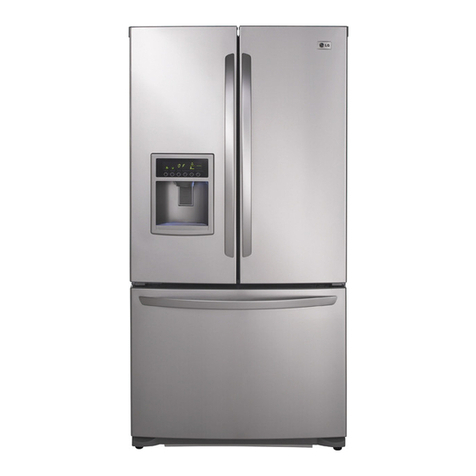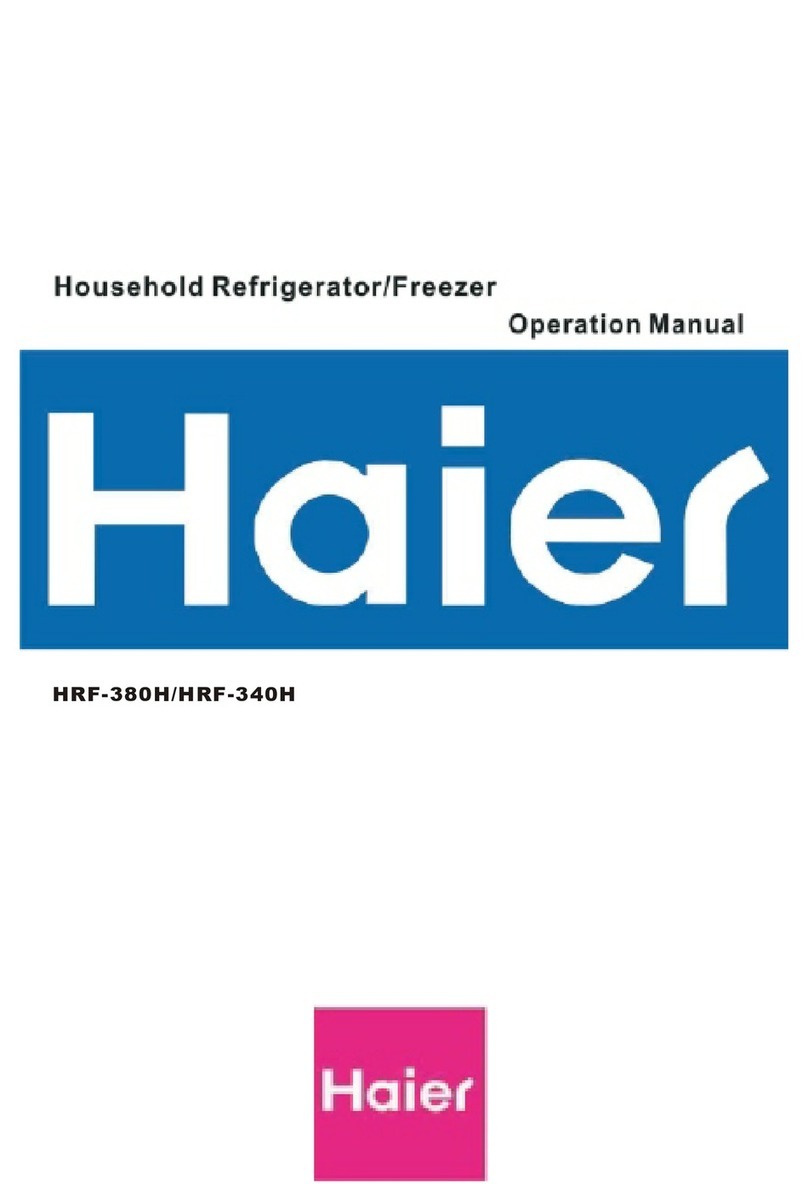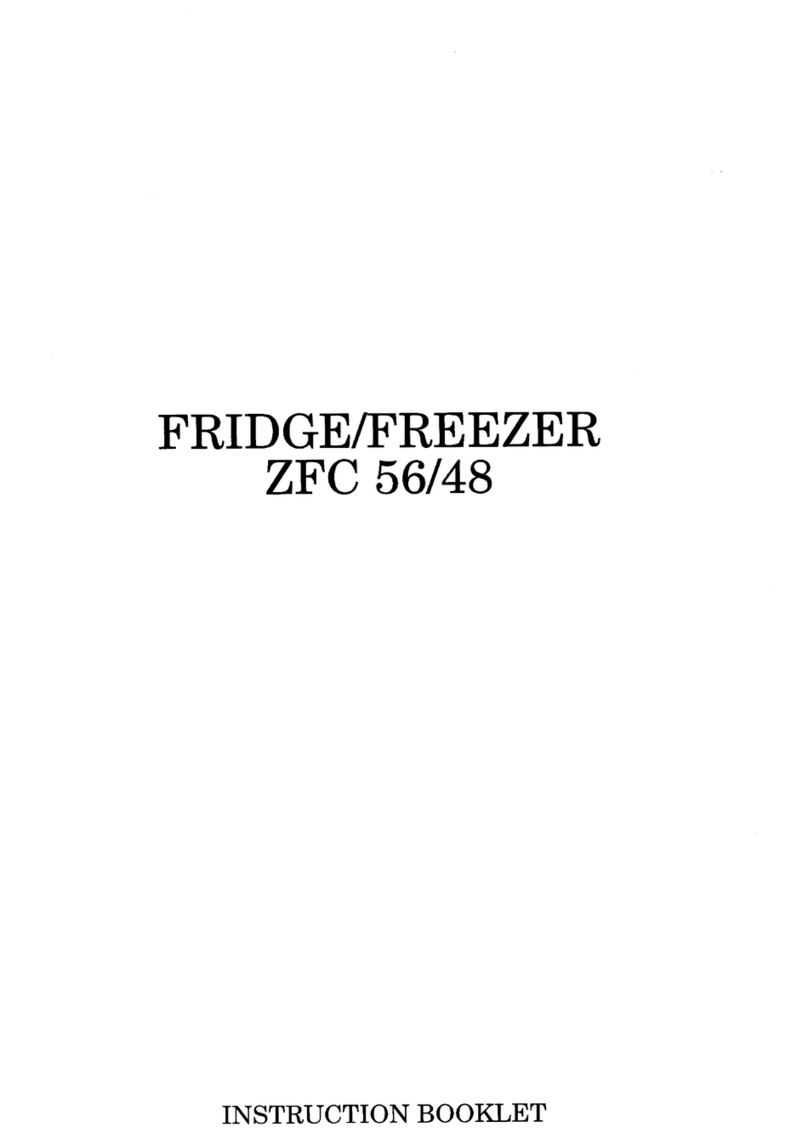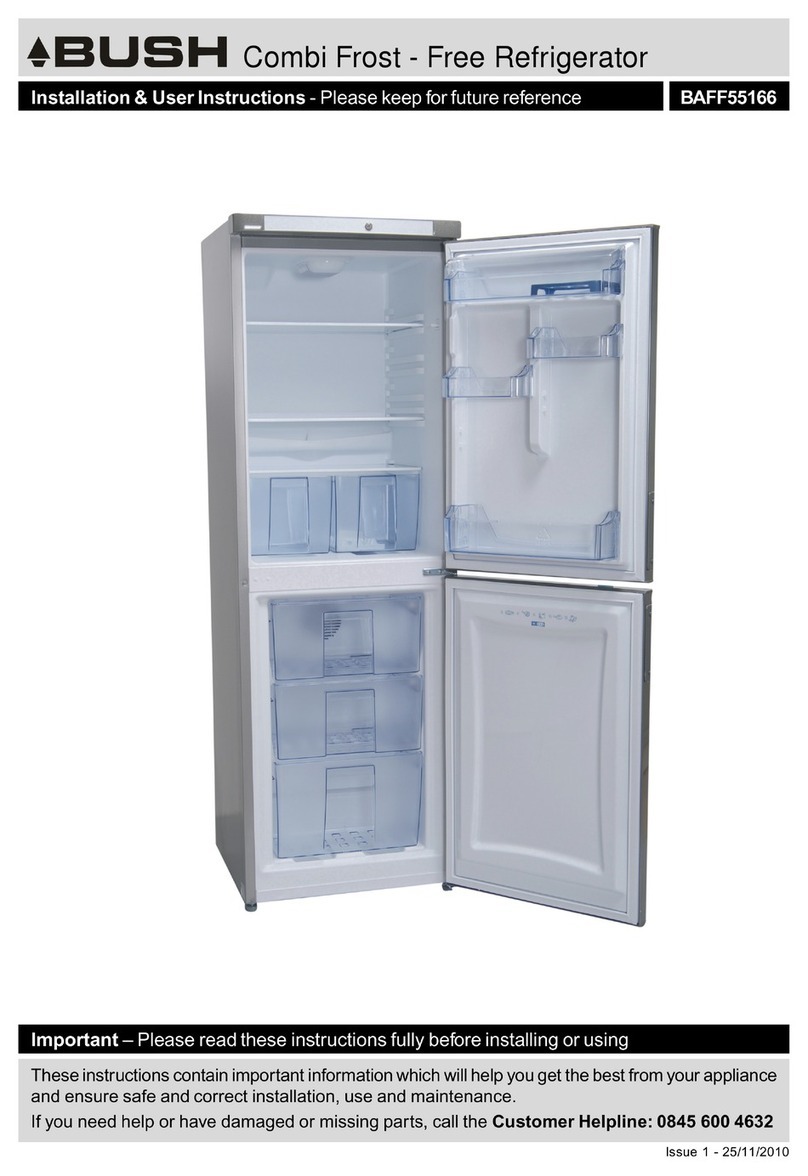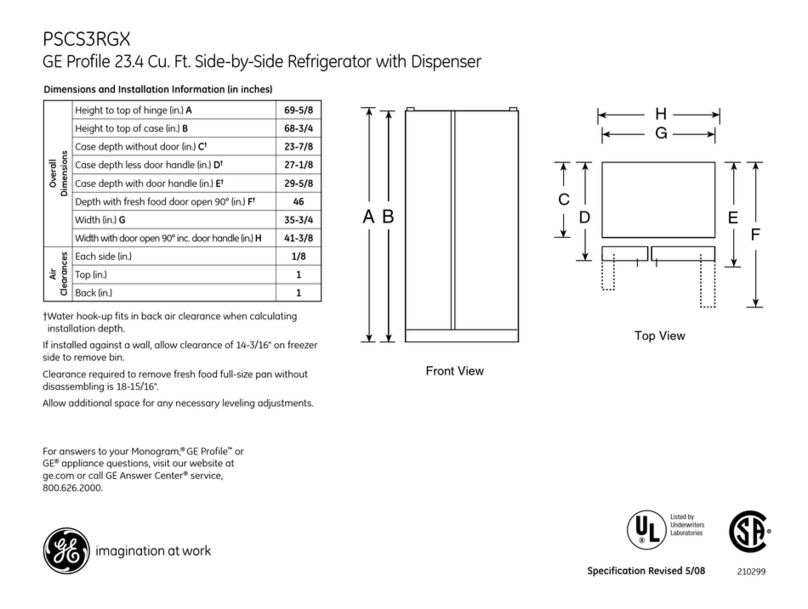PREMIER TECH PT-F47 User manual

INSTRUCTION MANUAL (EN)
REFRIGERATOR
MODEL: PT-F47 / PT-F47B
PT-F60 / PT-F60B
PT-F110 / PT-F110B
BEFORE USE, PLEASE READ AND FOLLOW ALL SAFETY RULES AND OPERATING
INSTRUCTIONS.
DADO SRL Via Petrara 81, 89124 Reggio Calabria (RC) Italy Piva/Vat IT 02681390809

1
IMPORTANT
• Use your refrigerator after 24 hours of delivery
or transport, leaving it positioned vertically in the
area where it will be installed.
• Place it in a suitable location, away from heat
sources and spaced from the wall to ensure a
sufficient air replacement

2
INSTALLATION INSTRUCTIONS
Before Using Your Refrigerator
•Remove the exterior and interior packing.
•Check to be sure you have all of the following parts:
•1 Ice Cube Tray
•1 Instruction Manual
•Before connecting the refrigerator to the power source, let it stand upright for approximately 2
hours. This will reduce the possibility of a malfunction in the cooling system from handling
during transportation.
•Clean the interior surface with lukewarm water using a soft cloth.
WARNING
IMPORTANT SAFETY INSTRUCTIONS
To reduce the risk of fire, electrical shock, or
injury when using your refrigerator, follow these
basic precautions:
•Read all instructions before using the refrigerator.
•DANGER or WARNING: Risk of child entrapment.
Child entrapment and suffocation are not problems of the past. Junked or abandoned
refrigerators are still dangerous . . . even if they will “just sit in the garage a few days.”
•Before you throw away your old refrigerator: Take off the door. Leave the shelves in
place so that children may not easily climb inside.
•Never allow children to operate, play with, or crawl inside the refrigerator.
•Never clean refrigerator parts with flammable fluids. The fumes can create a fire hazard
or explosion.
•Do not store or use gasoline or any other flammable vapors and liquids in the vicinity of
this or any other refrigerator. The fumes can create a fire hazard or explosion.
•This appliance can be used by children aged from 8 years and above and persons with
reduced physical, sensory or mental capabilities or lack of experience and knowledge if
they have been given supervision or instruction concerning use of the appliance in a safe
way and understand the hazards involved. Children shall not play with the appliance.
Cleaning and user maintenance shall not be made by children without supervision.
•If the supply cord is damaged, it must be replaced by the manufacturer, its service agent
or similarly qualified persons in order to avoid a hazard.
•WARNING: Keep ventilation openings, in the appliance enclosure or in the built-in
structure, clear of obstruction.
•WARNING: Do not use mechanical devices or other means to accelerate the defrosting
process, other than those recommended by the manufacturer.
•WARNING: Do not damage the refrigerant circuit.
•WARNING: Do not use electrical appliances inside the food storage compartments of the
appliance, unless they are of the type recommended by the manufacturer.
•Do not store explosive substances such as aerosol cans with a flammable propellant in
this appliance.
•This appliance is intended to be used in household and similar applications such as:
–staff kitchen areas in shops, offices and other working environments;
–farm houses and by clients in hotels, motels and other residential type environments;
–bed and breakfast type environments;
–catering and similar non-retail applications.
-Save these instructions-

3
Installing Your Refrigerator
•This appliance is designed to be free standing only, and should not be recessed or built-in.
•Place your refrigerator on a floor that is strong enough to support the refrigerator when it is
fully loaded. To level your refrigerator, adjust the leveling leg at the bottom of the refrigerator.
•Allow 12 cm of space between the back and sides of the refrigerator, which allows the
proper air circulation to cool the compressor.
•Locate the refrigerator away from direct sunlight and sources of heat (stove, heater, radiator,
etc.). Direct sunlight may affect the acrylic coating and heat sources may increase electrical
consumption. Extreme cold ambient temperatures may also cause the refrigerator not to
perform properly.
•Avoid locating the refrigerator in moist areas.
•Plug the refrigerator into an exclusive, properly installed-grounded wall outlet. Do not under
any circumstances cut or remove the third (ground) prong from the power cord. Any questions
concerning power and/or grounding should be directed toward a certified electrician or an
authorized service center.
•After plugging the appliance into a wall outlet, allow the unit to cool down for 2-3 hours before
placing food in the refrigerator compartment.
Electrical Connection
This refrigerator should be properly grounded for your safety. The power cord of this refrigerator is
equipped with a two-pin plug which mates with standard two prong wall outlets to minimize the
possibility of electrical shock.
Do not under any circumstances cut or remove the third ground prong from the power cord supplied.
This refrigerator requires a standard 220-240Volts A.C. ~/50Hz electrical outlet with two-prong
ground.
The cord should be secured behind the refrigerator and not left exposed or dangling to prevent
accidental injury.
Never unplug the refrigerator by pulling the power cord. Always grip the plug firmly and pull straight
out from the receptacle.
Do not use an extension cord with this appliance. If the power cord is too short, have a qualified
electrician or service technician install an outlet near the appliance
Reversing the Door Swing of Your Appliance
This refrigerator has the ability to open the door from the left or right side. The unit is delivered to you
with the door opening from the left side.
Reversing the side of the door opening is very simple.
PT-F47 / F47B and PT-F60 / F60B models:
• Remove the lower bracket at the base on the right side of the door;
• Remove the door from the housing and remove the screws on the top of the fridge after removing
the covers;
• Reverse the upper door housing in the opposite holes, insert the door after removing the plugs of the
left holes and screw the lower bracket.
Warning
Improper use of the grounded plug can result in the risk of electrical shock. If the power cord is
damaged, have it replaced by an authorized service center.

4
Model PT-F110 / F110B:
• Remove the lower bracket at the base on the right side of the door;
• Remove the door from the housing and remove the screws located under the top of the fridge (On
the front right side);
• Invert the upper housing in the opposite holes, insert the door after removing the plugs of the left
holes and screw the lower bracket.
OPERATING YOUR REFRIGERATOR
Setting the Temperature Control
•To control the internal temperature, adjust the control dial according to the ambient
temperature or purpose of use.
•The first time you turn the unit on, set the temperature control to “6.”
•The temperature control range is from "OFF" to "6". After 24-48 hours from the first power on
of the refrigerator, adjust the temperature control to the setting that best meets your needs
taking into account that temperatures vary from 8 ° / 6 ° degrees in minimum setting "1" up to
a maximum of 2 ° degrees in setting "6" of the control dial easily adjustable by turning the
knob inside the refrigerator compartment. The "3" setting of about 4 degrees should be
appropriate for use in the home or office.
•NOTE: If the unit is unplugged, has lost power, or is turned off; you must wait 3 to 5 minutes
before restarting the unit. If you attempt to restart before this time delay, the refrigerator will
not start.
•
Use of the Ice Cube Tray
•For your ice requirements, fill approximately ¾ of the tray after washing it.
•If you want to make ice cubes quick, set thermostat to position “6”.
•To release the ice cubes, hold the tray upside down and twist slightly at
both ends until the pieces of ice fall.
Adjusting the feet
To level the feet on the front of the appliance base simply rotate the feet manually to the right or left,
until the desired height is reached. In this way they can be adjusted according to your needs.
TIP: If the front of the refrigerator is slightly higher than the back, the door will open and close more
easily.

5
The Chiller Compartment
NOTE: Unlike freezer compartments in the models
PT-F47 / PT-F47B and PT-F60 / PT-F60B, the chiller compartment
present in the model PT-F110 / PT-F110B has the functions of a 4-star freezer with
minimum temperature reached -24 ° degrees.
•This compartment is designed for production of ice cubes and short-term storage (3-4 days at
most) of some commercially frozen foods.
•The temperature in this compartment does not get cold enough to freeze food safely for long
periods of time and works best when the food is already frozen.
•By design, this chiller compartment is NOT a true freezer, and may not keep ice cream frozen, or
freeze items.
•A colder setting may be used for these items, but other items in the refrigerator may also be
affected.
•The chiller door is susceptible to breaking due to excessive ice build up. This part is not covered
under your warranty. Be sure to defrost when the ice reaches ¼ inch thick
CARE AND MAINTENANCE
Defrosting Your Refrigerator
Defrost the refrigerator when the frost accumulated on the evaporator is about 5mm (1/5 inch) thick.
Set the thermostat dial to “OFF” position. Remove frozen or perishable foods. Defrosting usually takes
a few hours. After defrosting, return the thermostat dial to the desired position. To defrost quickly
remove all foods from the refrigerator and leave the door open. Never use a knife or other metal
instrument to scrape ice/frost from the evaporator.
Cleaning Your Refrigerator
•Turn the temperature control to "OFF", unplug the refrigerator, and remove the food, shelves,
and trays.
•Wash the inside surfaces with a warm water and baking soda solution. The solution should be
about 2 tablespoons of baking soda to a quart of water.
•Wash the shelves and trays with a mild detergent solution.
•The outside of the refrigerator should be cleaned with mild detergent and warm water.
•Wring excess water out of the sponge or cloth before cleaning the area of the controls, or any
electrical parts.
•Wash the outside cabinet with warm water and mild liquid detergent. Rinse well and wipe dry
with a clean soft cloth.
•
Replace the lamp (in models equipped)
First take off the lamp cover and screw off the old lamp. Then screw the new lamp into the lamp
holder. Finally assemble lamp cover.
Vacation Time
•Short vacations: Leave the refrigerator operating during vacations of less than three weeks.
•Long vacations: If the refrigerator will not be used for several months, remove all food and
unplug the power cord. Clean and dry the interior thoroughly. To prevent odor and mold growth,
leave the door open slightly: blocking it open if necessary.

6
Moving Your Refrigerator
•Remove all the food.
•Securely tape down all loose items inside your refrigerator.
•Turn the leveling screw up to the base to avoid damage.
•Tape the door shut.
•Be sure the refrigerator stays secure in the upright position during transportation. Also protect
the outside of refrigerator with a blanket, or similar item.
➢Energy Saving Tips
•The refrigerator should be located in the coolest area of the room, away from heat producing
appliances, and out of the direct sunlight.
•Let hot foods cool to room temperature before placing in the refrigerator. Overloading the
refrigerator forces the compressor to run longer.
•Be sure to wrap foods properly, and wipe containers dry before placing them in the
refrigerator. This cuts down on frost build-up inside the refrigerator.
•Refrigerator storage bin should not be lined with aluminum foil, wax paper, or paper toweling.
Liners interfere with cold air circulation, making the refrigerator less efficient.
•Organize and label food to reduce door openings and extended searches. Remove as many
items as needed at one time, and close the door as soon as possible.

7
PROBLEMS WITH YOUR REFRIGERATOR
You can solve many common refrigerator problems easily, saving you the cost of a possible service
call. Try the suggestions below to see if you can solve the problem before calling the servicer.
TROUBLESHOOTING GUIDE
PROBLEM
POSSIBLE CAUSE
Refrigerator does not operate.
Not plugged in.
The circuit breaker tripped or a blown fuse.
The refrigerator temperature control is set at
"OFF".
Turns on and off frequently.
The room temperature is hotter than normal.
A large amount of food has been added to the
refrigerator.
The door is opened too often.
The door is not closed completely.
The temperature control is not set correctly.
The door gasket does not seal properly.
The refrigerator does not have the correct
clearances.
Vibrations.
Check to assure that the refrigerator is level.
The refrigerator seems to make too much noise.
The rattling noise may come from the flow of the
refrigerant, which is normal.
As each cycle ends, you may hear gurgling
sounds caused by the flow of refrigerant in your
refrigerator.
Contraction and expansion of the inside walls
may cause popping and crackling noises.
The refrigerator is not level.
The door will not close properly.
The refrigerator is not level.
The door was reversed and not properly installed.
The gasket is dirty.
The shelves, bins, or baskets are out of position.
° Prohibited reproduction - Texts owned by the trademark PremierTech
DADO SRL Via Petrara 81, 89124 Reggio Calabria (RC) Italy Piva/Vat IT 02681390809 V150319

8
MANUALE DI ISTRUZIONI (IT)
FRIGORIFERO
MODELLO: PT-F47 / PT-F47B
PT-F60 / PT-F60B
PT-F110 / PT-F110B
PRIMA DELL'USO, LEGGERE E SEGUIRE TUTTE LE NORME DI SICUREZZA E LE
ISTRUZIONI OPERATIVE.
DADO SRL Via Petrara 81, 89124 Reggio Calabria (RC) Italy Piva/Vat IT 02681390809

9
IMPORTANTE
•Utilizzare il vostro frigorifero dopo 24 ore dalla
consegna o trasporto lasciandolo posizionato
verticalmente nella zona dove verrà installato.
•Posizionarlo in un luogo adeguato, lontano da
fonti di calore e distanziato dalla parete almeno
12cm per garantire un sufficiente ricambio d’aria.

10
ISTRUZIONI DI INSTALLAZIONE
PRIMA DI UTILIZZARE IL TUO FRIGORIFERO
•Rimuovere l’imballaggio esterno e interno.
•Verificare di disporre di tutte le parti seguenti:
•1 vassoio per cubetti di ghiaccio
•1 Manuale di Istruzioni
AVVERTENZA
ISTRUZIONI IMPORTANTI DI SICUREZZA
Per ridurre il rischio di incendio, scosse elettriche o
lesioni durante l'utilizzo del frigorifero, seguire le
seguenti precauzioni di base:
•Leggere tutte le istruzioni prima di utilizzare il frigorifero
•PERICOLO O AVVERTENZA: Rischio di intrappolamento del bambino.
L'intrappolamento e il soffocamento dei bambini sono problemi da non sottovalutare. I frigoriferi rotti
o abbandonati sono ancora pericolosi ... “Anche se sono fermi nel garage per qualche giorno”.
•Prima di buttare via il tuo vecchio frigorifero: Togli la porta. Lascia da parte gli scaffali/ripiani in
modo che i bambini non possano facilmente salire all'interno.
•Non consentire mai ai bambini di operare, giocare o gattonare all'interno del frigorifero.
•Non pulire mai le parti del frigorifero con liquidi infiammabili in quanto i fumi potrebbero creare un
rischio di incendio o esplosione.
•Non conservare o usare benzina o altri vapori e liquidi infiammabili nelle vicinanze di questo o di
altri frigoriferi. I fumi possono creare un rischio di incendio o esplosione.
•Questo elettrodomestico può essere utilizzato da bambini di età pari o superiore a 8 anni e
persone con ridotte capacità fisiche, sensoriali o mentali o mancanza di esperienza e conoscenza
se hanno ricevuto supervisione o istruzioni sull'uso dell'apparecchio in modo sicuro
comprendendone i rischi. I bambini non devono giocare con l'apparecchio. La pulizia e la
manutenzione dell'utente non devono essere eseguite da bambini senza supervisione.
•Se il cavo di alimentazione è danneggiato, per evitare rischi, deve essere sostituito dal produttore,
dal suo agente di assistenza o da personale qualificato.
•AVVERTENZA: Mantenere prive di ostruzioni le aperture di ventilazione nell'armadio
dell'apparecchio o nella struttura incorporata.
•AVVERTENZA: Non utilizzare dispositivi meccanici o altri mezzi diversi da quelli raccomandati dal
produttore per accelerare il processo di scongelamento.
•AVVERTENZA: Non danneggiare il circuito del refrigerante.
•AVVERTENZA: Non utilizzare apparecchi elettrici all'interno dei vani portaoggetti dell'apparecchio
a meno che non siano del tipo raccomandato dal produttore.
•Non conservare sostanze esplosive come bombolette spray con un propellente infiammabile in
questo apparecchio.
•Questo elettrodomestico è destinato all'uso in applicazioni domestiche e simili come:
–Aree di cucina per il personale in negozi, uffici e altri ambienti di lavoro;
–Fattorie e clienti in alberghi, motel e altri ambienti di tipo residenziale;
–Ambienti di tipo bed and breakfast;
–Ristorazione e simili applicazioni non al dettaglio;
–Farmacie, ospedali e studi clinici.
-Conserva queste istruzioni-
I rifiuti di prodotti elettrici non devono essere smaltiti con i rifiuti domestici. Si
prega di riciclare nelle strutture predisposte. Rivolgersi al proprio ente locale o
al rivenditore per i consigli sul riciclaggio.

11
Importante: Utilizzare il vostro frigorifero dopo 24 ore dalla consegna o trasporto
lasciandolo posizionato verticalmente nella zona dove verrà installato. Posizionarlo in
un luogo adeguato, lontano da fonti di calore e distanziato dalla parete almeno 12cm
per garantire un sufficiente ricambio d’aria.
CONSIGLIO: Pulire la superficie interna con acqua tiepida usando un panno morbido.
Installazione del frigorifero
•Questo apparecchio è progettato per essere utilizzato solo in piedi e non deve essere
incassato o integrato.
•Collocare il frigorifero su un pavimento sufficientemente resistente per sostenere il frigorifero
quando è completamente carico. Per livellarne l’altezza regolare i piedini di livellamento nella
parte inferiore del frigorifero.
•Lasciare 12 cm di spazio tra la parte posteriore e i lati del frigorifero. Ciò consentirà la
corretta circolazione dell'aria per raffreddare il compressore.
•Posizionare il frigorifero lontano dalla luce solare diretta e da fonti di calore (fornello,
riscaldamento, radiatore, ecc.). La luce solare diretta può influenzare il rivestimento acrilico e
le fonti di calore possono aumentare il consumo elettrico. Temperature fredde estreme
ambientali possono causare anch’esse il malfunzionamento del frigorifero.
•Evitare di posizionare il frigorifero in aree umide.
•Collegare il frigorifero a una presa a parete esclusiva e correttamente installata a terra. Non
tagliare o rimuovere in alcun caso il terzo polo (terra) dal cavo di alimentazione. Eventuali
domande riguardanti l'alimentazione e / o la messa a terra devono essere indirizzate verso un
elettricista certificato o un centro di assistenza autorizzato.
•Dopo aver collegato l'apparecchio a una presa a muro, lasciare raffreddare l'unità per 2-3
ore prima di disporre i cibi nel vano frigorifero.
Connessione Elettrica
•Questo frigorifero richiede una presa elettrica standard da 220-240Volt a C.C. ~ / 50Hz con
messa a terra a due poli (obbligatoria la messa a terra per la vostra sicurezza, evitare scosse
elettriche e danneggiamenti al prodotto).
•Il cavo deve essere fissato dietro il frigorifero e non deve essere lasciato esposto o pendente
per evitare lesioni accidentali.
•Non scollegare mai il frigorifero tirando il cavo di alimentazione. Afferrare sempre saldamente
la spina ed estrarla dalla presa.
•Non utilizzare una prolunga con questo apparecchio. Se il cavo di alimentazione è troppo
corto, chiedere ad un elettricista o tecnico qualificato di installare una presa vicino
all'apparecchio.
Avvertenza
L'uso improprio della spina messa a terra può comportare il rischio di scosse elettriche. Se il cavo
di alimentazione è danneggiato, si deve farlo sostituire in un centro di assistenza autorizzato.

12
Inversione dell’apertura della porta del dispositivo
Questo frigorifero ha la capacità di aprire la porta dal lato sinistro o destro. L'unità viene consegnata a
te con la porta che si apre dal lato sinistro.
Invertire il lato dell’apertura della porta è semplicissimo.
Modelli PT-F47/F47B e PT-F60/F60B:
•Rimuovere la staffa inferiore posta alla base sul lato destro della porta;
•Sfilare la porta dall’alloggio e togliere le viti poste sul top del frigo dopo averne tolto i tappi;
•Invertire l’alloggio superiore della porta nei fori opposti, inserire la porta dopo averne tolto i
tappi dei fori di sinistra ed avvitare la staffa inferiore.
Modello PT-F110/F110B:
•Rimuovere la staffa inferiore posta alla base sul lato destro della porta;
•Sfilare la porta dall’alloggio e togliere le viti poste sotto il top del frigo (Sul lato anteriore
destro);
•Invertire l’alloggio superiore nei fori opposti, inserire la porta dopo averne tolto i tappi dei fori
di sinistra ed avvitare la staffa inferiore.
UTILIZZO DEL TUO FRIGORIFERO
Impostazione del controllo della temperatura
•Per controllare la temperatura interna, regolare il quadrante di controllo in base alla
temperatura dell'ambiente o allo scopo di utilizzo.
•La prima volta che si accende l'unità, impostare il controllo della temperatura su "6."
•L'intervallo del controllo della temperatura va dalla posizione "OFF" a "6". Dopo 24-48 ore
dalla prima accensione del frigorifero, regolare il controllo della temperatura sull'impostazione
che meglio soddisfa le vostre esigenze tenendo conto che le temperature variano dagli
8°/6°gradi in impostazione minima “1” fino ad un massimo di 2°gradi in impostazione “6” del
quadrante di controllo regolabile facilmente ruotando la manopola all’interno dello scomparto
frigo. L'impostazione "3" di circa 4°gradi dovrebbe essere appropriata per l'uso in casa o in
ufficio.
NOTA:
▪Se l'unità è scollegata, ha perso il potere refrigerante o è spenta è necessario attendere da 3 a 5
minuti prima di riavviare l'unità. Se si tenta di riavviarlo prima, il frigorifero non si avvia.
Uso del vassoio per I cubetti di ghiaccio
•Per i requisiti di ghiaccio, riempire circa ¾ del vassoio dopo averlo lavato.
•Se vuoi preparare velocemente i cubetti di ghiaccio, imposta il termostato
sulla posizione "6".
•Per rilasciare i cubetti di ghiaccio, tenere il vassoio capovolto e ruotare
leggermente su entrambe le estremità finché i pezzi di ghiaccio non
cadono.

13
Regolazione dei piedini
Per livellare i piedini posti sulla parte anteriore della base dell’elettrodomestico occorre
semplicemente ruotare manualmente, a destra o a sinistra, i piedini fino al raggiungimento dell’altezza
desiderata. In tal modo potranno essere regolati in base alle vostre esigenze.
CONSIGLIO: Se la parte anteriore del frigorifero è leggermente più alta del retro, la porta si aprirà e si
chiuderà più facilmente.
Il comparto del refrigeratore
NOTA BENE: A differenza degli scomparti freezer presenti nei modelli
PT-F47/PT-F47B e PT-F60/PT-F60B, il comparto del refrigeratore
presente nel modello PT-F110/PT-F110B ha le funzioni di un congelatore a 4 stelle con
temperatura minima raggiungibile di -24° Gradi.
•Questo comparto è progettato per la produzione di cubetti di ghiaccio e la conservazione a breve
termine (al massimo 3-4 giorni) di alcuni alimenti commercialmente congelati.
•La temperatura in questo comparto non diventa abbastanza fredda da congelare i cibi in modo
sicuro per lunghi periodi di tempo e funziona meglio quando il cibo è già congelato.
•In base alla progettazione, questo compartimento refrigeratore NON è paragonabile ad un
congelatore e potrebbe non congelare il gelato o altri prodotti.
•È possibile utilizzare un'impostazione più fredda per tali articoli, ma potrebbero essere coinvolti
anche altri articoli nel frigorifero.
•Lo sportello del refrigeratore è suscettibile a rotture a causa dell'eccessivo accumulo di ghiaccio.
Questa parte non è coperta dalla garanzia. Assicurarsi di scongelare quando il ghiaccio
raggiunge uno spessore di 0,5 cm.
CURA E MANUTENZIONE
Sbrinamento del frigorifero
Sbrinare il frigorifero quando la brina accumulata sull'evaporatore è di circa 5 mm (1/5 di pollice) di
spessore. Impostare il quadrante del termostato sulla posizione "OFF". Rimuovere alimenti congelati
o deperibili. Lo sbrinamento richiede in genere alcune ore. Dopo lo sbrinamento, riportare il quadrante
del termostato nella posizione desiderata. Per scongelare rapidamente rimuovere tutti gli alimenti dal
frigorifero e lasciare la porta aperta. Non usare mai un coltello o un altro strumento metallico per
raschiare il ghiaccio dall'evaporatore.

14
Pulizia del frigorifero
•Ruotare il controllo della temperatura su "OFF", scollegare il frigorifero e rimuovere cibo,
ripiani e vassoi.
•Lavare le superfici interne con acqua tiepida e soluzione di bicarbonato di sodio. La soluzione
dovrebbe essere composta da circa 2 cucchiai di bicarbonato di sodio per un litro di acqua.
•Lavare i ripiani e i vassoi con una soluzione detergente delicata.
•L'esterno del frigorifero deve essere pulito con un detergente delicato e acqua tiepida.
•Strizzare l'eccesso di acqua dalla spugna o dal panno prima di pulire l'area dei comandi o
qualsiasi parte elettrica.
•Lavare l'armadio esterno con acqua tiepida e detergente liquido delicato. Risciacquare bene
e asciugare con un panno morbido pulito.
Sostituire la lampada (nei modelli che la prevedono)
Rimuovere il coperchio della lampada, svitare e gettare la vecchia lampada, avvitare la nuova
lampada nel proprio alloggio ed infine assemblare nuovamente il coperchio.
Periodi di vacanza
•Vacanze brevi: Lasciare il frigorifero in funzione durante le vacanze di meno di tre settimane.
•Lunghe vacanze: Se il frigorifero non viene utilizzato per diversi mesi, rimuovere tutto il cibo e
scollegare il cavo di alimentazione. Pulire e asciugare accuratamente l'interno. Per prevenire
l'odore e la crescita delle muffe, lasciare la porta leggermente aperta e bloccarla se necessario.
Spostamento del frigorifero
•Rimuovere tutto il cibo.
•Fissare in modo sicuro tutti gli oggetti sfusi all'interno del frigorifero.
•Ruotare la vite di livellamento fino alla base per evitare danni.
•Chiudere la porta con nastro adesivo.
•Assicurarsi che il frigorifero rimanga sicuro in posizione verticale durante il trasporto. Proteggere
anche l'esterno del frigorifero con una coperta o un oggetto simile.
Consigli per il risparmio energetico
•Il frigorifero deve essere collocato nella zona più fredda della stanza, lontano da fonti di calore e
lontano dalla luce solare diretta.
•Lasciare raffreddare gli alimenti caldi a temperatura ambiente prima di metterli in frigorifero. Il
sovraccarico del frigorifero costringe il compressore a funzionare più a lungo.
•Avvolgere gli alimenti correttamente e asciugare i contenitori prima di metterli nel frigorifero.
Questo riduce l'accumulo di brina all'interno del frigorifero.
•Il contenitore del frigorifero non deve essere rivestito con fogli di alluminio, carta oleata o carta da
cucina. Tali componenti interferiscono con la circolazione dell'aria fredda rendendo il frigorifero
meno efficiente.
•Organizzare ed etichettare il cibo per ridurre le aperture delle porte e le ricerche estese.
Rimuovere tutti gli elementi necessari in un’unica volta e chiudere la porta il prima possibile.

15
PROBLEMI CON IL TUO FRIGORIFERO
È possibile risolvere facilmente molti problemi comuni del frigorifero risparmiando il costo di una
possibile chiamata di assistenza. Prova i suggerimenti qui sotto per vedere se è possibile risolvere il
problema prima di chiamare il tecnico.
GUIDA ALLA RISOLUZIONE DEI PROBLEMI
PROBLEMA
POSSIBILE CAUSA
Il frigorifero non funziona
Non collegato.
Interruttore automatico scattato o fusibile
bruciato.
Il controllo della temperatura del frigorifero è
impostato su "OFF".
Si accende e si spegne frequentemente
La temperatura della stanza è più calda del
normale.
Una grande quantità di cibo è stata aggiunta al
frigorifero.
La porta viene aperta troppo spesso.
La porta non è completamente chiusa.
Il controllo della temperatura non è impostato
correttamente.
La guarnizione della porta non si chiude
correttamente.
Il frigorifero non ha le distanze corrette dalla
parete.
Vibrazioni
Verificare che il frigorifero sia in piano.
Il frigorifero sembra fare troppo rumore
Il rumore sferrante può provenire dal flusso del
refrigerante, che è normale.
Alla fine di ogni ciclo, potresti sentire dei suoni
gorgoglianti causati dal flusso di refrigerante nel
tuo frigorifero.
La contrazione e l'espansione delle pareti interne
possono causare rumori scoppiettanti.
Il frigorifero non è in piano.
La porta non si chiude correttamente
Il frigorifero non è in piano.
La porta è stata invertita e non installata
correttamente.
La guarnizione è sporca o usurata.
Gli scaffali, i contenitori o i cesti sono fuori
posizione.
Per richieste d'assistenza scrivere a: assistenza@premiertech.it
°Riproduzione vietata- Testi di proprietà del marchio PremierTech
DADO SRL Via Petrara 81, 89124 Reggio Calabria (RC) Italy Piva/Vat IT 02681390809
V150319
This manual suits for next models
5
Table of contents
Languages:
Other PREMIER TECH Refrigerator manuals
